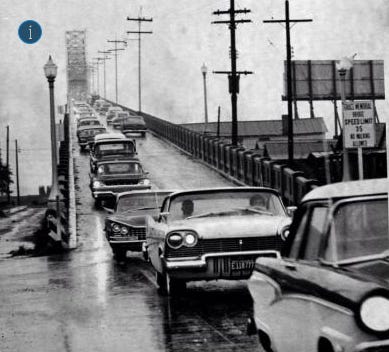#52: South Carolina BBQ, Ravenel Bridge, and a Hilton Head Island Land Trust dinner
For South Carolina history lovers far and wide! Enjoy weekly SC history and upcoming SC historical events
Dear reader,
Welcome to Newsletter #52 of The South Carolina History Newsletter! I’m so happy you’re here.
Also, thank you to Brittany, a new subscriber friend, who asked a question about Charles Pinckney Jr. from Newsletter #50. There were multiple Charles Pinckneys in SC history and they were all prominent statesmen, which of course, can lead to much confusion! Charles Pinckney Jr. was cousin to Charles Cotesworth Pinckney, son of Eliza Lucas Pinckney, famous for propagating indigo in South Carolina. To help us all, I have found a family tree below for clarification, and I hope to a do a newsletter soon with more information on this distinguished family :)
I’d like to extend a special welcome to the following new subscribers — woohoo!
kellyconfer
mjaholloway
jamesmadisonjr1971
wschaufler2
riotboo
lorikinglocke
thomasjaylynn1970
ceschwartz224
cschwartz663
I hope you enjoy today’s newsletter, and as always, please feel free to reply to this email with your ideas and suggestions on South Carolina history you’d like to learn more about. I’m only a click away.
Additionally, please join us & keep the conversation going by becoming a member of our SC History Newsletter Facebook Community here! I can’t wait to meet you.
And now, let’s learn some South Carolina history!
Yours truly,
Kate
(Writing from Greenville, SC)
➳ Featured SC History Event
Please enjoy our featured SC History Event below, and click here to visit my SC History Events Calendar that organizes all the upcoming SC history events I have discovered. Please let me know if you’d like to add an event to the calendar! Reply to this email or send me a note at schistorynewsletter@gmail.com.
Friday, May 3rd, 2024 | “2024 Hilton Head Island Land Trust BBQ Dinner & Annual Meeting” | Hilton Head Land Trust | Hilton Head, SC | TICKETS: $125
“Our Annual Meeting and BBQ Dinner returns with celebrated guest Peach Hubbard of The Dolphin Project! The evening is a fundraiser for the Land Trust, whose mission is to preserve and protect critical natural habitat and significant historical parcels of land on Hilton Head Island for the enjoyment of future generations. For 37 years, the Hilton Head Island Land Trust has preserved and protected wetlands, green space, and historic properties on Hilton Head through conservation easements. Your support helps us continue monitoring and maintaining not only Hilton Head Island's First Raptor Cam, but also our Trust Properties which promote environmental awareness and local history to our island community, visitors, and tourists. Sponsorships for the dinner are still available; please get in touch with hhilandtrust@hhilandtrust.org for more information.”
➳ SC History Fun Facts
I.
Did you know that South Carolina’s most famous BBQ sauce is often referred to as “Carolina Gold”?
The word barbecue derives from the Spanish word barbacoa, which has its origin in an indigenous word barabicu, found in the “language of the Arawak people of the Caribbean and the Timucua people of Florida.” The Oxford English Dictionary traces the word to Hispaniola and translates it as a "framework of sticks set upon posts." A popular theory also says that barbeque is derived from the French barbe à queue ("from beard to tail") signifying a whole animal being roasted on a spit, though this is not supported by academic etymology.
The barbeque we know and love today came from the fateful combination of Native American cooking techniques over the open flame and the early Spanish colonists in the 1500s introducing pigs and pork to the New World. While I was not able to find a definitive answer on where barbeque with pork first began, many sources claim that it started in the Spanish colony of Santa Elena, located in the area that we now call Port Royal in Beaufort County, South Carolina.
According to the South Carolina Barbeque Association:
There are generally considered to be four types of barbeque in the country and they, by and large, are broken down by the type of sauce use in basting and also as a finish sauce, used when the barbeque is being served. Those four, in order of historical emergence, are Vinegar and Pepper, Mustard, Light Tomato and Heavy Tomato. And while there is always disagreement on the varieties of preparation, such as whether one should use a dry rub or a wet rub and various other culinary arguments, all of the many sauces used in America generally will fall into one of those four basic groups. North and South Carolina share three of the four types of barbeque sauce that Americans normally use. But only South Carolina is the home of all four.
The first and “original” barbeque sauce, dating back hundreds of years, is Vinegar and Pepper. It is found on the coastal plains of “both North and South Carolina and to a slight degree in Virginia and Georgia.” Vinegar and Pepper sauce is attributed to The Scottish families who settled primarily in Williamsburg County in present day South Carolina Lowcountry.
In chronological order, the second of the four sauces is the one that is most distinct to South Carolina — Mustard Sauce. It is sometimes called "Carolina Gold." We have early German settlers to thank for the gift of mustard. Starting in the 1730s, the then-British colony of South Carolina encouraged, recruited, and paid the ocean passage for thousands of German families to settle land along the Santee, Congaree, Broad and Saluda Rivers. These German settlers were hardworking, resourceful people who brought to the New World their European farming style, Lutheran beliefs, and most importantly in this case, their mustard.
Even today, some of the most famous mustard based sauces come from German families. According to the South Carolina Barbeque Association, the Bessinger family is the “most prominent in the mustard-based barbeque business,” but other German names like Shealy, Hite, Sweatman, Sikes, Price, Lever, Meyer, Kiser, and Zeigler are also well known in the South Carolina barbeque business.
The third type of sauce found in South Carolina is Light Tomato sauce. This sauce is (or was) little more than Vinegar and Pepper with tomato ketchup added. This sauce evolved when tomato ketchup became a readily available condiment around 1900. This style of sauce is most famous in North Carolina where Lexington is the acknowledged “barbeque center.” It is also popular in the upper middle part of South Carolina and in the South Carolina Pee Dee region.
The fourth style of barbeque sauce is Heavy Tomato sauce. This sauce has evolved over the last 60 years. It is the type of sauce that most Americans think of as barbeque sauce, and the one most widely sold in stores. It was popularized by Kraft Foods and it is found on “every store shelf, thanks to the miracle of twentieth century motorized transportation.”
In terms of preparation, barbecue in South Carolina is typically prepared by smoking meat over hickory or oak, and heavily features pork rather than beef. Whole hog barbecue, where an entire pig is cooked over hardwood coals, is common in the Pee Dee region. The pig is sometimes skinned prior to cooking and the skin is fried. Smoked pork shoulder is another distinctive style of barbecue associated with South Carolina, as is pork butt and ham.
Which is your favorite style of BBQ sauce? Leave a comment below!
II.
Did you know that the Ravenel Bridge’s 1,546 feet main span was the longest in the Western Hemisphere when it was completed in 2005?
Before Charleston’s iconic Ravenel Bridge, there were two other bridges that connected the city with Mt. Pleasant: the “functionally obsolete” 2-lane Grace Bridge (1929) and 3-lane Pearman Bridge (1966), locally known as the “Old Cooper River Bridge” and the “New Cooper River Bridge.” Apparently driving over these old bridges was a nightmare. Many people refused to use the bridges because they were so unsafe, and this limited opportunities for the growth of the Mt. Pleasant community. The city needed a solution, and fast.
US Congressman Arthur Ravenel, Jr. stepped up to the challenge and started a 20-year funding effort to replace the bridges. The overall price of the new bridge was approximately $700 million. Funding came from local, state, and federal sources. As a testament to his part in securing the funding, the bridge was named after Arthur Ravenel Jr. and is known simply as the “Ravenel Bridge.”
Construction on the bridge began with a groundbreaking ceremony in Mt. Pleasant in 2001. The bridge was a design-build project in a joint venture between two companies (Tidewater Skanska of Norfolk, Virginia and Flatiron Constructors of Longmont, Colorado) operating under the name Palmetto Bridge Constructors. All construction occurred while the old bridges remained fully operational with “old spans and cars passing below in some places.”
The Ravenel Bridge is a cable-stayed suspension bridge with dual diamond towers, each rising 575 feet high. At 1,546 feet, the main span was the longest in the Western Hemisphere when it was completed. It is now the third longest. 128 cables connect the towers above to the roadway below.
Engineers designed the Ravenel Bridge to withstand earthquakes, high hurricane winds, and even the possibility of being hit by ships (which actually happened to the Grace Bridge in 1946). Engineers considered the 1886 earthquake that nearly leveled Charleston and made sure the Ravenel Bridge could withstand an earthquake of approximately 7.4 on the Richter scale. To protect the bridge from any “errant ships” (particularly pertinent in the wake of the recent Baltimore Key Bridge collapse) the towers are flanked by one-acre rock islands. Ships will run aground on the islands before colliding with the towers.
The bridge has 8 lanes for vehicular traffic, plus bicycle and pedestrian lanes. Fun fact that the initial design called for the tops of the towers to feature large beacons of light that would be seen for miles. However, wildlife conservationists pushed back, saying that the lights would “confuse endangered sea turtle hatchlings from following the moon to the waterline.” As a result, the bridge only has functional, not decorative, lighting.
A week of festivities led up to the official opening of the bridge on July 16th, 2005. The opening included a gourmet dinner served on the bridge and the opportunity for all citizens to walk the lanes before they opened to vehicular traffic. It is said that the “number of people who turned out that day equaled the entire population of Charleston.” The evening before the opening, a concert with a fireworks display (the largest in Charleston history) lit up the sky. The bridge opened “1 year ahead of schedule and under budget.”
Crossing the bridge is now a “marvel instead of a hazard.” Now that there is a safe bridge to cross, the population of Mt. Pleasant has grown. The bridge has been featured in popular culture in music, movies, and television shows, and it is also the centerpiece of the annual Cooper Bridge Run, one of the largest 10Ks in the country.
In 2024, the Ravenel Bridge was named the “#6 Most Iconic Bridge in America that commuters would like to drive over” coming in just behind San Francisco’s Golden Gate Bridge at #5. In addition to vehicular traffic above and boats below, walking and biking on the bridge “is a mainstay” for tourists and athletes, as well as commuters. The bridge also inspires many amateur and professional photographers, as well as visual artists, with its monumental and elegant design.
Have you biked or walked over the Ravenel Bridge? Have you done the Cooper River Run? If so, please leave a comment and tell us about it!
➳ Quote from an SC historical figure
I.
Sunday Afternoon Walk, Ravenel Bridge
“This will not be the last bridge we cross.
He’s at that age, the chiseled ridges
of a man, still a child in the face.
We walk uphill as concrete and cable beam
hold us for now. Gales and earthquake,
won’t break a sturdy build, but this?
Up here nothing hedges us from wind.
Below is the slow coast of vessels:
a fishboat, a rusty barge.
Land and sea blur into blue-green, my eyes
turn high tide wet, a pressed kerchief
still tucked in my pocket.”
—Poem by Danielle Verwers from Poetry Society of South Carolina
Sources used in today’s newsletter:
I always want to improve my work. Answer the poll below to give me your review of today’s newsletter. I also welcome your suggestions for new content! Simply reply to this email with your ideas. Thank you!
























